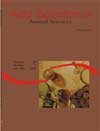<b>Evaluation of residual feed intake in young bulls of the Polled Nellore breed in a performance test</b> - DOI: 10.4025/actascianimsci.v30i4.6464
Keywords:
beef cattle, feed efficiency, improve, selection.
Abstract
This study evaluated the characteristics: age, weight, daily weight gain (DWG), dry matter intake (DMI), feed conversion (FC), feed efficiency (FE) and residual feed intake (RFI) of young bulls of the Polled Nellore breed in a performance test. Thirty bulls, with initial age of 243.6±30.4 days were used. Dry Matter Intake (DMI) was quantified daily for each animal. The animals were classified by the performance test index (PTI). RFI did not show differences (p > 0.05) among the averages of the groups. The variables weight and DWG were not correlated with RFI. There was high correlation between RFI and FC. FE and FC showed correlation with RFI. The PTI showed high correlation with DMI (r = 0.75). When comparing mean RFI among the bulls, it was observed that less efficient animals showed a DMI 27.7% superior to the most efficient animals. The variable PTI did not identify the most efficient animals in dry matter utilization, because there were low correlations with FC, FE and RFI. It can be concluded that the bull selection for PTI selects those that shows more weight gain; however, they have more DMI. It is possible to improve the methodology for selection with the inclusion of RFI.Downloads
Download data is not yet available.
Published
2009-03-05
How to Cite
Bonin, M. de N., Demarchi, J. J. A. de A., Mizubuti, I. Y., Ribeiro, E. L. de A., Manella, M. de Q., & Pereira, E. S. (2009). <b>Evaluation of residual feed intake in young bulls of the Polled Nellore breed in a performance test</b> - DOI: 10.4025/actascianimsci.v30i4.6464. Acta Scientiarum. Animal Sciences, 30(4), 425-433. https://doi.org/10.4025/actascianimsci.v30i4.6464
Issue
Section
Ruminant Nutrition
DECLARATION OF ORIGINALITY AND COPYRIGHTS
- I Declare that current article is original and has not been submitted for publication, in part or in whole, to any other national or international journal.
The copyrights belong exclusively to the authors. Published content is licensed under Creative Commons Attribution 4.0 (CC BY 4.0) guidelines, which allows sharing (copy and distribution of the material in any medium or format) and adaptation (remix, transform, and build upon the material) for any purpose, even commercially, under the terms of attribution.
Read this link for further information on how to use CC BY 4.0 properly.
0.9
2019CiteScore
29th percentile
Powered by 








































